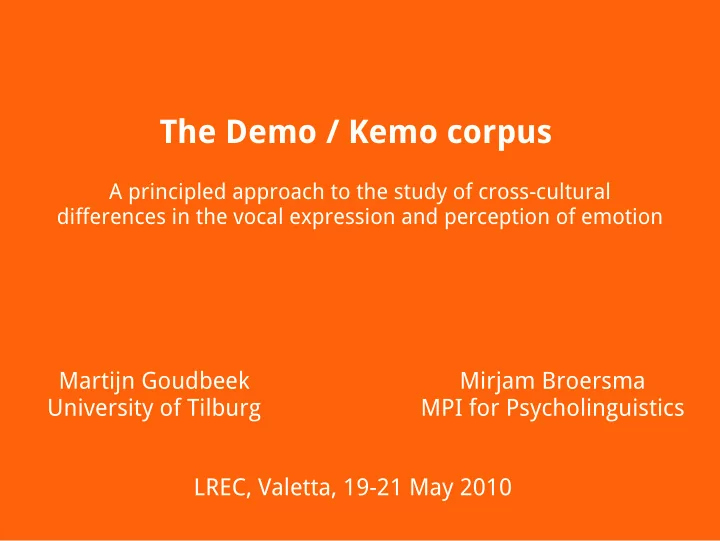

The Demo / Kemo corpus A principled approach to the study of cross-cultural differences in the vocal expression and perception of emotion Martijn Goudbeek Mirjam Broersma University of Tilburg MPI for Psycholinguistics LREC, Valetta, 19-21 May 2010
Two designs in cross-cultural The Kemo / Demo perception of emotion: corpus: One-to-many and Many-to-many many-to-one Future plans and Corpus discussion construction
Cross-cultural perception of emotion ● Basic emotions (joy, anger, fear, disgust, sadness) are recognized well above chance between cultures ● Other emotions (pride, shame, pleasure) depend more on cultural factors
Cross-cultural perception of emotion ● Most of this research has been done in the facial domain ● The vocal domain is interesting since it simultaneously communicates linguistic content and emotional meaning ● The field has addressed the study of cross-cultural emotion perception with two research designs
Many-to-one versus One-to-many Many-to-one versus One-to-many Two approaches to constructing corpora in the study of cross-cultural differences in the vocal expression of emotion Many-to-one and One to many designs
Many-to-one versus One-to-many Many-to-one versus One-to-many One-to-many design Use an existing corpus of emotional expression that has been developed and validated in one language to assess the ability of speakers from one or more other languages to successfully decode the emotional expressions
Many-to-one versus One-to-many Many-to-one design Develop and validate a corpus in several languages and then present the expressions to listeners from one language
Many-to-one versus One-to-many L2 L2 L1 L3 L3 L1 L4 L4 Listeners Listeners Speakers Speakers
Many-to-one versus One-to-many • Neither design unambiguously separates effects of language and emotion: • Emotions are expressed with non-native phonetic characteristics • There are no within language controls that listen to both the L1 and L2 versions • Solution: a many-to-many design
Many-to-many L1 L1 L2 L2 Listeners Speakers
The Demo / Kemo corpus ● Dutch and Korean actors ● 8 emotions x 8 actors (4 M, 4 F) x 2 languages ● Carrier phrase: “nutohom seppikang” ● Meaningless in both languages ● Phonetically / phonotactically possible in both languages ● No embedded words
The Demo / Kemo corpus Emotions Valence Positive Negative Joy Anger A High r Pride Fear o u s Tenderness Sadness a Low l Relief Irritation
The Demo / Kemo corpus Recording sessions ● Scenario approach, but also free improvisation ● In interaction with a stage director ● Order of emotions randomized over actors ● Four valid emotion portayals ● Validation by forced choice identification
The Demo / Kemo corpus Examples
The Demo / Kemo corpus Validation study • 24 listeners from each language (Nijmegen and Seoul) • 8 emotions x 8 speakers x 4 repetitions = 256 utterances per language • Praat MFC experiment with naturalness rating • Results expressed in unbiased hitrates
Corpus construction • From the four rated portrayals the best two were selected based on • The unbiased hitrate (Hu) • Confusions with other emotions • Goodness ratings • Chance (if all else failed) • This resulted in a corpus with 256 expressions
Corpus construction Average unbiased hitrates 0.6 Dutch Korean 0.5 Unbiased hitrate 0.4 0.3 0.2 0.1 0 Anger Fear Sadness Joy Irritation Pride Relief Tenderness Emotion
Corpus construction Statistical analysis • Significant effect of emotion: some emotions are better recognized than others • No significant effect of language • No significant interaction between language and emotion • Conclusion : quality of recordings equally well for both languages / all emotions recognized equally well in both languages
Future plans and discussion Many-to-many perception experiment L1 L1 L2 L2
Future plans and discussion • Acoustic analysis; duration • Several small corpora or one big one? • Availability: email the authors: mirjam@mirjambroersma.nl m.b.goudbeek@uvt.nl
Recommend
More recommend